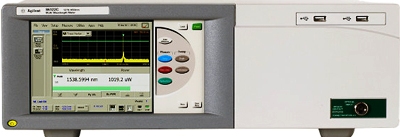
|
|
The Agilent 86122C Multi-Wavelength Meter is an updated version of the 86122A and 86122B. The product is used to efficiently develop, manufacture and verify tunable transmitter lasers and optical subsystems for today's and tomorrow’s high-speed applications. For its reliability and durability, this product family is equally popular on the manufacturing floor and engineers’ benches, and it is robust enough to be installed on ships. Statistical data from a large share of the industry’s installed wavelength meters enables us to continuously fine-tune our instruments for lower cost of ownership and longer usage, particularly in 24/7 operated testing: we have extended the recommended recalibration period of the 86122C to two years, and doubled the expected lifetime of the built-in reference laser. To ensure continued supportability, the 86122C is based on Windows ® 7. Front and rear panel accessible USB ports host USB flash drives for data exchange, mouse and keyboard for comfortable operation. With an absolute wavelength accuracy of ±0.2 ppm and ±0.15 ppm differential accuracy, the new Agilent 86122C Multi-Wavelength Meter belongs in the top class of wavelength meters available for optical communication testing. Its wavelength range of 1270 to 1650 nm covers all fiber-to-the-home, metro and long-haul transmission systems. The instrument can measure the spectra of up to 1,000 laser lines at once, which is more than sufficient for fully populated dense-wavelength-division multiplexed systems (DWDM). Specifications. Wavelength : 1270 nm to 1650 nm. Absolute accuracy (lines separated by >=10 GHz): ±2 ppm (±0.3 pm at 1550 nm and 1310 nm). Minimum resolvable separation (equal power lines input) (characteristic): 5 GHz (0.04 nm at 1550 nm, 0.03 nm at 1300 nm) for laser lines separated by >=10 GHz. Display resolution: 0.0001 nm. Amplitude Linearity (Lines above -30 dBm): ±0.3 dB (1270 to 1600 nm). Flatness, ±30 nm from any wavelength (characteristic): 1270 to1600 nm ±0.2 dB, 1270 to1650 nm ±0.5 dB. Display resolution: 0.01 dB. Polarization Dependence: ±0.5 dB (1270 to 1600 nm), ±1.0 dB (characteristic) (1600 to 1650 nm). Sensitivity Single Line Input: –32 dBm (1270 to 1600 nm), –22 dBm (1600 to 1650 nm). Selectivity (characteristic): 25 dB (spacing >= 90 GHz), 10 dB (spacing >= 10 GHz). Maximum safe input level (sum of all lines): +18 dBm. Measure up to 1000 laser lines simultaneously. Measurement Cycle Time 0.5 s. Options. 021: Straight (non-angled) Contact Interface-PC (default). 022: Angled Contact Interface-APC.
|